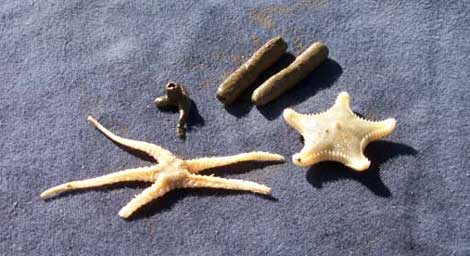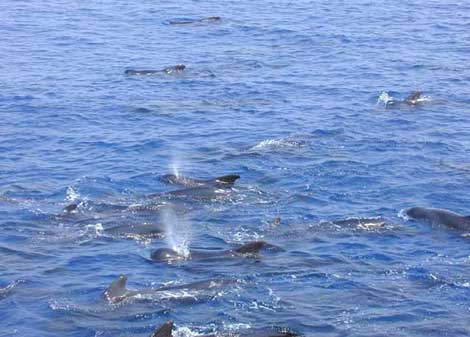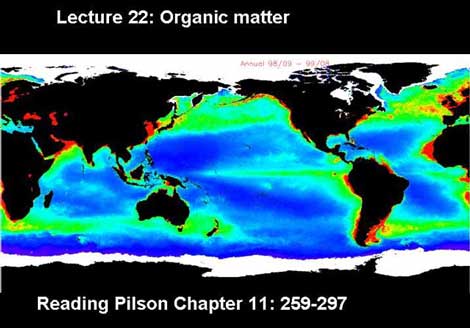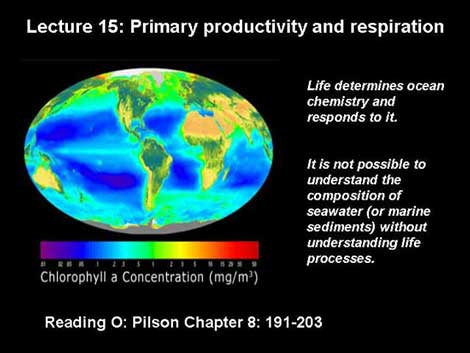Daily Journal
December 11, 2004: Marine Life
In this last journal, we look at life in the ocean.
Test your knowledge of marine flora and fauna.
1. T/F You probably consume a seaweed derivative quite often.
2. T/F Giant kelp can grow up to 200 feet long.
3. T/F The ocean does not contribute oxygen to the atmosphere.
4. T/F All starfish have 5 arms.
5. T/F Starfish are fish.
6. T/F Starfish can regenerate new arms.
7. Why are whales mammals?
8. How long can a whale hold its breath?
9. What do whales eat?
10. Yes/No Do all dolphins live in the ocean?
11. Yes/No Are dolphins and porpoises the same?
12. Yes/No Can dolphins hear better than humans?
Question 1: True, you probably do consume a seaweed derivative quite often. Kelp produces algin. Algin is used in the manufacture of such diverse products as ice cream, salad dressing, beer, toothpaste, and cosmetics.
Healthy kelp beds are necessary to sustain life in the sea. Some sea animals use the kelp beds for food; others use them for shelter.
Question 2: True. Smaller kelp may have only one branch and be less than a meter long.
Question 3: False, plants in the ocean produce chlorophyll just as plants do on land. See the graphic to identify regions with higher production levels of chlorophyll.
Question 4: False, though most species of starfish, more correctly called sea stars, have 5 arm-like appendages, but some species of sea star can have as many as 40 arms.
Question 5: False, sea stars belong to a classification called echinoderm. They are in the same group as sea cucumbers, sea urchins, brittle stars, sea lilies and sand dollars. Echinoderm is the only phylum (scientific classification) that is made up of only marine life.
Question 6: True, a sea star can regenerate lost arms and can shed an arm as a defensive measure against predators. Sea star bodies are an excellent example of radial symmetry. They have a central hub with arms spreading out like the spokes on a bike wheel.
Question 7: Whales are warm-blooded, give birth to live offspring and give them milk. They do not have gills like fish; they breathe oxygen. Whales have only a few stiff hairs on their heads.
Question 8: It depends on the kind of whale. Baleen whales usually breathe every 5-15 minutes. They can hold their breath for up to 40 minutes. The whale that can hold its breath the longest is the sperm whale which can go up to 2 hours without breathing.
Question 9: Large baleen whales feed mainly on plankton. Toothed whales may eat fish or squid. Sometime they eat crab, octopus, or cuttlefish.
Question 10: No, there are also fresh water dolphins. The Amazon River has pink dolphins.
Question 11: No, they are very similar but have differences in the snout (nose) and teeth. Dolphins have a beak shaped snout with cone shaped teeth. Porpoises have a rounded snout and flat spade-shaped teeth.
Question 12: Yes, dolphins hear a much wider range of sounds than humans can hear. They don't, however, have a sense of smell.
Challenge question: One photograph is of pilot whales which are really dolphins. Can you name another marine mammal that is commonly called a whale but is really a dolphin?
Information on marine life is from: World Book 2001
We hope you enjoyed the journals and learned a lot. We have enjoyed bringing them to you and hope that one day you too will have an opportunity to explore the ocean. We would like to close with a quote from Rachel Carson in "The Sea Around Us."
"When I think of the (deep sea) floor, the single, overwhelming fact that possesses my imagination is the accumulation of sediments. I see always the steady, unremitting downward drift of materials from above, flake, upon flake, layer upon layer ñ a drift that has continued for hundreds of millions of years, that will go on for as long as there are seas and continents for the sediments are the materials of the most stupendous snowfall the earth has ever seen."

sea stars and polychaete worms

pilot whales


Back to Daily Journals

|







